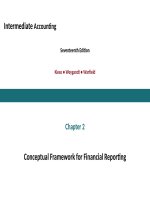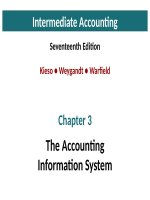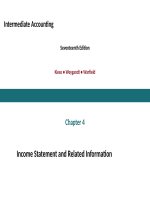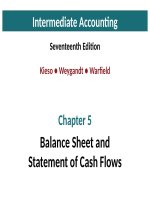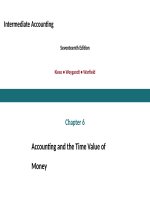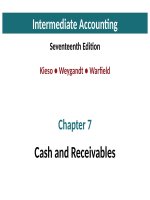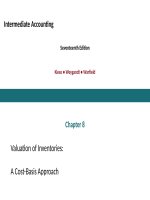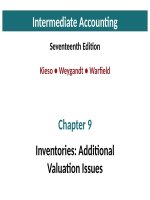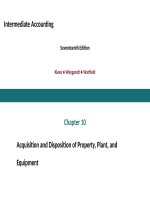Intermediate accounting 17e by kieso ch15
Bạn đang xem bản rút gọn của tài liệu. Xem và tải ngay bản đầy đủ của tài liệu tại đây (940.66 KB, 79 trang )
Intermediate Accounting
Seventeenth Edition
Kieso ● Weygandt ● Warfield
Chapter 15
Stockholders’ Equity
This slide deck contains animations. Please disable animations if they cause issues with your device.
Learning Objectives
After studying this chapter, you should be able to:
1.
Describe the corporate form and the issuance of shares of stock.
2.
Describe the accounting and reporting for reacquisition of shares.
3.
Explain the accounting and reporting issues related to dividends.
4.
Indicate how to present and analyze stockholders’ equity.
Copyright ©2019 John Wiley & Sons, Inc.
2
Preview of Chapter
Stockholders’ Equity
Corporate Capital
•
Corporate form
•
Components of equity
•
Issuance of stock
•
Preferred stock
Copyright ©2019 John Wiley & Sons, Inc.
3
Preview of Chapter
Stockholders’ Equity
Reacquisition of Shares
•
Purchase
•
Sale
•
Retirement
Copyright ©2019 John Wiley & Sons, Inc.
4
Preview of Chapter
Stockholders’ Equity
Dividend Policy
•
Financial condition and dividend distributions
•
Types of dividends
•
Stock dividends and stock splits
Presentation and Analysis
•
Presentation
•
Analysis
Copyright ©2019 John Wiley & Sons, Inc.
5
Learning Objective 1
Describe the Corporate Form and the Issuance of Shares of Stock
LO 1
Copyright ©2019 John Wiley & Sons, Inc.
6
Corporate Capital
Three primary forms of business organization
•
Proprietorship
•
Partnership
•
Corporation
Special characteristics of the corporate form:
LO 1
1.
Influence of state corporate law.
2.
Use of capital stock or share system.
3.
Development of a variety of ownership interests.
Copyright ©2019 John Wiley & Sons, Inc.
7
Corporate Capital
State Corporate Law
•
Corporation must submit articles of incorporation to the state in which incorporation is
desired.
•
State issues a corporation charter.
•
Advantage to incorporate in a state whose laws favor the corporate form of business
organization (Delaware).
•
Accounting for stockholder’s equity follows the provisions of each state’s business
incorporation act.
LO 1
Copyright ©2019 John Wiley & Sons, Inc.
8
Corporate Capital
Capital Stock or Share System
In the absence of restrictive provisions, each share carries the following rights:
1.
To share proportionately in profits and losses.
2.
To share proportionately in management (the right to vote for directors).
3.
To share proportionately in assets upon liquidation.
4.
To share proportionately in any new issues of stock of the same class—called the preemptive
right.
LO 1
Copyright ©2019 John Wiley & Sons, Inc.
9
Corporate Capital
Variety of Ownership Interests
Common stock is the residual corporate interest.
•
Bears ultimate risks of loss.
•
Receives the benefits of success.
•
Not guaranteed dividends nor assets upon dissolution.
Preferred stock is a special class of stock created by contract, when stockholders’ sacrifice certain
rights in return for other rights or privileges, usually dividend preference.
LO 1
Copyright ©2019 John Wiley & Sons, Inc.
10
Components of Stockholders’ Equity
LO 1
Copyright ©2019 John Wiley & Sons, Inc.
11
Corporate Capital
Issuance of Stock
Accounting problems involved in the issuance of stock:
1.
Par value stock.
2.
No-par stock.
3.
Stock issued in combination with other securities.
4.
Stock issued in noncash transactions.
5.
Costs of issuing stock.
LO 1
Copyright ©2019 John Wiley & Sons, Inc.
12
Issuance of Stock
Par Value Stock
Low par values help companies avoid a contingent liability.
Corporations maintain accounts for:
LO 1
•
Preferred Stock or Common Stock.
•
Paid-in Capital in Excess of Par (also called Additional Paid-in Capital).
Copyright ©2019 John Wiley & Sons, Inc.
13
Par Value Stock
Illustration: Blue Diamond Corporation issued 300 shares of $10 par value common stock for $4,500.
Prepare the journal entry to record the issuance of the shares.
Cash
LO 1
4,500
Common Stock (300 × $10)
3,000
Paid-in Capital in Excess of Par Value
1,500
Copyright ©2019 John Wiley & Sons, Inc.
14
Issuance of Stock
No-Par Stock
Reasons for issuance:
•
Avoids contingent liability.
•
Avoids confusion over recording par value versus fair market value.
A major disadvantage of no-par stock is that some states levy a high tax on these issues. In addition, in
some states the total issue price for no-par stock may be considered legal capital, which could reduce the
flexibility in paying dividends.
LO 1
Copyright ©2019 John Wiley & Sons, Inc.
15
No-Par Stock
Illustration: Video Electronics Corporation is organized with authorized common stock of 10,000 shares
without par value. If Video Electronics issues 500 shares for cash at $10 per share, it makes the following
entry.
Cash
5,000
Common Stock
LO 1
5,000
Copyright ©2019 John Wiley & Sons, Inc.
16
Issuance of Stock
State Value Stock
Illustration: Some states require that no-par stock have a stated value. If a company issued 1,000 of the
shares with a $5 stated value at $15 per share for cash, it makes the following entry.
Cash
15,000
Common Stock
5,000
Paid-in Capital in Excess of Stated Value
LO 1
Copyright ©2019 John Wiley & Sons, Inc.
10,000
17
Corporate Capital
Stock Issued with Other Securities (Lump-Sum)
Two methods of allocating proceeds:
1.
Proportional method.
2.
Incremental method.
LO 1
Copyright ©2019 John Wiley & Sons, Inc.
18
Proportional Method
Illustration: Beveridge Corporation issued 300 shares of $10 par value common stock and 100 shares of $50 par value
preferred stock for a lump sum of $13,500. Common stock has a market value of $20 per share, and preferred stock has a
market value of $90 per share.
LO 1
Copyright ©2019 John Wiley & Sons, Inc.
19
Proportional Method
Journal Entry
Cash
LO 1
13,500
Preferred Stock (100 x $50)
5,000
Paid-in Capital in Excess of Par-Preferred
3,100
Common Stock (300 x $10)
3,000
Paid-in Capital in Excess of Par-Common
5,000
Copyright ©2019 John Wiley & Sons, Inc.
20
Incremental Method
Illustration: Beveridge Corporation issued 300 shares of $10 par value common stock and 100 shares of $50 par value
preferred stock for a lump sum of $13,500. The common stock has a market value of $20 per share, and the value of preferred
stock is unknown.
LO 1
Copyright ©2019 John Wiley & Sons, Inc.
21
Incremental Method
Journal Entry
Cash
LO 1
13,500
Preferred Stock (100 x $50)
5,000
Paid-in Capital in Excess of Par-Preferred
2,500
Common Stock (300 x $10)
3,000
Paid-in Capital in Excess of Par-Common
3,000
Copyright ©2019 John Wiley & Sons, Inc.
22
Corporate Capital
Stock Issued in Noncash Transactions
The general rule: Companies should record stock issued for services or property other than cash at
the
•
fair value of the stock issued or
•
fair value of the noncash consideration received,
whichever is more clearly determinable.
LO 1
Copyright ©2019 John Wiley & Sons, Inc.
23
Stock Issued in Noncash Transactions
Illustration: The following series of transactions illustrates the procedure for recording the issuance of 10,000 shares
of $10 par value common stock for a patent for Marlowe Company, in various circumstances.
1.
Marlowe cannot readily determine the fair value of the patent, but it knows the fair value of the stock is
$140,000.
Patents
140,000
Common Stock
100,000
40,000
Paid-in Capital in Excess of Par - Common
LO 1
Copyright ©2019 John Wiley & Sons, Inc.
24
Stock Issued in Noncash Transactions
Fair Value $150,000
2.
Marlowe cannot readily determine the fair value of the stock, but it determines the fair value of the patent is
$150,000.
Patents
150,000
Common Stock
100,000
50,000
Paid-in Capital in Excess of Par - Common
LO 1
Copyright ©2019 John Wiley & Sons, Inc.
25
